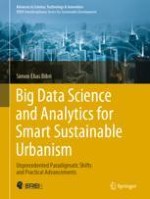Abstract
We are moving into an era where instrumentation, datafication, and computation are routinely pervading the very fabric of cities, coupled with the interlinking, integration, and coordination of their systems and domains. As a result, vast troves of contextual and actionable data are being produced and used to operate, regulate, manage, and organize urban life. This data-driven approach to urbanism has recently become the mode of production for smart sustainable cities, which are accordingly becoming knowable, tractable, and controllable in new dynamic ways, responsive to the data generated about them by reacting to the analytical outcome of many domains of urban life in terms of enhancing and optimizing operational functioning, planning, design, development, and governance in line with the goals of sustainable development. However, topical studies tend to deal mostly with data-driven smart urbanism while barely exploring how this approach can improve and advance sustainable urbanism under what is labeled ‘data-driven smart sustainable cities’ as a leading paradigm of urbanism. Having a threefold aim, this chapter first examines how data-driven smart sustainable cities are being instrumented, datafied, and computerized so as to improve, advance, and maintain their contribution to the goals of sustainable development through enhanced practices. Secondly, it highlights and substantiates the real potential of big data technology for enabling such contribution by identifying, synthesizing, distilling, and enumerating the key practical and analytical applications of this advanced technology in relation to multiple urban systems and domains with respect to operations, functions, services, designs, strategies, and policies. Thirdly, it proposes, illustrates, and describes a novel architecture and typology of data-driven smart sustainable cities. This chapter intervenes in the existing scholarly conversation by calling attention to a relevant object of study that previous scholarship has neglected and whose significance for the field of urbanism is well elucidated, as well as by bringing new insights to and informing the ongoing debate on smart sustainable urbanism in light of big data science and analytics. This work serves to bring data-analytic thinking and practice to smart sustainable urbanism, and seeks to promote and mainstream its adoption, in addition to drawing special attention to the crucial role and enormous benefits of big data technology and its novel applications as to transforming the future form of such urbanism.
